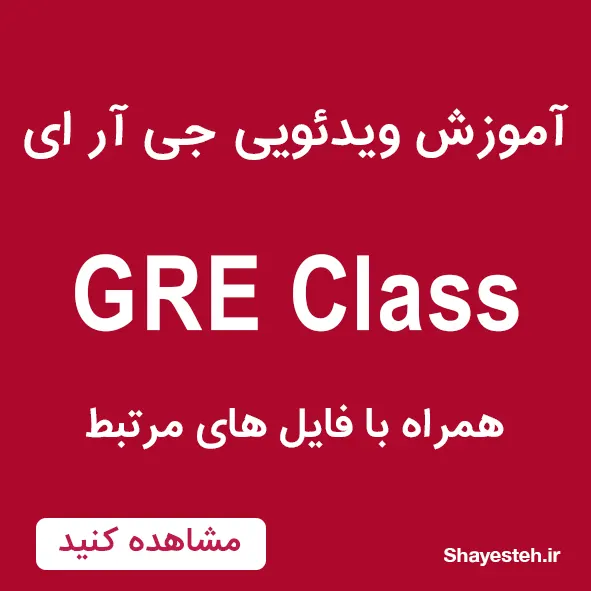در صورتی که اشکالی در ترجمه می بینید می توانید از طریق شماره زیر در واتساپ نظرات خود را برای ما بفرستید
09331464034
Topic:
The following appeared in a letter to the editor of Parson City's local newspaper.
"In our region of Trillura, the majority of money spent on the schools that most students attend — the city-run public schools — comes from taxes that each city government collects. The region's cities differ, however, in the budgetary priority they give to public education. For example, both as a proportion of its overall tax revenues and in absolute terms, Parson City has recently spent almost twice as much per year as Blue City has for its public schools — even though both cities have about the same number of residents. Clearly, Parson City residents place a higher value on providing a good education in public schools than Blue City residents do."
Write a response in which you discuss what specific evidence is needed to evaluate the argument and explain how the evidence would weaken or strengthen the argument.
موارد زیر در نامه ای به سردبیر روزنامه محلی پارسون سیتی آمده است.
در منطقه ما در تریلورا، بیشتر بودجه هزینه شده برای مدارسی که اکثر دانش آموزان در آن تحصیل می کنند- مدارس دولتی اداره شده شهرستان- از مالیاتی بدست می آید که دولت هر شهر دریافت می کند. شهرهای منطقه از نظر اولویت بودجه ای که به آموزش عمومی می دهند، متفاوت هستند. به عنوان مثال، پارسون سیتی اخیراً هم به عنوان نسبت درآمد کلی مالیاتی خود و هم در شرایط مطلق، تقریباً سالیانه دو برابر بیشتر از شهر بلو برای مدارس دولتی خود هزینه کرده است - اگرچه هر دو شهر تقریباً به یک اندازه سکنه دارند. واضح است که ساکنان شهر پارسون ارزش بیشتری برای ارایه آموزش خوب در مدارس دولتی نسبت به ساکنان شهر بلو قائل هستند.
پاسخی بنویسید که در آن بحث کنید که چه دلیل خاصی برای ارزیابی بحث لازم است و توضیح دهید که چگونه دلایل می تواند بحث را تضعیف یا تقویت کند.
Strategies
Argument:
Because Parson City has spent twice as much of its tax revenue as Blue City has on education, Parson City places a greater value on providing a good education as does Blue City.
In developing your response, you must determine what evidence the planning committee needs to uncover before making its final budget decisions for its City spends on its public-school students demonstrate that it places more value on education than Blue City does.
Facts and Assumptions:
a) The majority of money spent on public schools in Trillura comes from city tax revenue.
b) Parson City has recently spent almost twice as much per year as Blue City has for its public schools. The logical assumption that follows is that Parson City spends twice as much per student as Blue City does. Blue City may have more students on private schools. Parson City may have recently had to replace one of its schools, adding a significant amount to its yearly school budget. The word recently is a qualifier. Did Blue City spend more than Parson City in the past?
c) Parson City and Blue City have about the same number of residents. This may lead to the assumption that each city has the same number of public-school students. In fact, Blue City may have a very different demographic than Parson City.
Your notes do not have to be exhaustive. As you begin to write your essay, your brain will generate new ideas. Make certain that you keep the directions in mind as you develop your ideas.
Sample 1:
In this letter to the editor, the writer has taken the position that Parson City places a higher value on educating its children than does Blue City. The writer cites budget figures from the two cities to support his position. Since letters to the editor express an opinion, the reader should always accept the facts with a good deal of skepticism. Acknowledging that the writer's purpose is to persuade, the reader should demand some concrete evidence before accepting that opinion as fact.
The author's first statement is likely true. It is the case in most communities everywhere that local schools are supported, in large part, by local tax dollars and that the largest part of a community's budget is expended on its schools. However, to suggest that the amount of money that a community spends is a reflection of the value it places on education is misleading. A number of factors influence how much of a city's budget, both in real dollars and percentage of the total budget, is allocated for public schools. The reader should seek evidence of the existence of any extenuating circumstances that would account for the greater amount spent in Parson City.
Consider the demographic of each community. The author states that both communities have about the same number of residents, a statement easily verified by looking at census results. The composition of each city's total may vary. Again, by scrutinizing census records, one can discover how many residents comprise each age group. If Parson City has considerably more school-age children than Blue City does, the reason for the greater expenditure on public schools becomes patently obvious. Blue City, in fact, may be home to an aging population. A large portion of that city's budget may go to services for the elderly.
In addition, Parson City may have had to replace an aging school building, leaking roofs or windows, or an antiquated heating system. Any of those capital improvements would influence the school budget for a few years. The writer uses the word recently when comparing the two communities' public-school expenditures. Is there evidence that, at some period in the recent past, Blue City spent more than Parson City on its schools? Blue City may have recently finished paying for capital improvements to its schools and, as a result, has been able to reduce its school budget.
A final assumption is that spending more money on education makes that education better. More money can buy more books and the latest technology; it can build beautiful schools and reduce classroom size. However, only the school district’s philosophy can create good education. Many schools deliver an excellent education to its students while operating on a shoestring. Good education is measured by the achievement of students, not by the size of the budget.
In its current form, this letter to the editor provides too many vague statements and too little evidence for the reader to accept that Parson City places more value on education than does Blue City. Only if facts are uncovered to support the idea that Parson City is spending more per pupil than Blue City is can the residents of Parson City feel a sense of superiority regarding education in its public schools.
Sample 2:
The author of the above given argument holds the view that various cities of the region of Treehaven differ in the value they place on public education. The author supports his stand by saying that the amount of money spent by Parson City on its schools is two times that spent by Blue City despite having about the same population that pays taxes. Therefore, according to the author, Parson City residents value public education more than Blue City residents. However, the author seems to be looking at the issue within a narrow scope. Instead of making conclusions with the little data that he has, the author should try to find out more facts to support his argument.
As mentioned, the facts that the author presents to support his argument are not sufficient to form conclusions and decide about the importance a region places on education. First of all, what can be said for one city may not be true for other cities. Each city spends its share of taxes on different services. This cannot be compared because the needs of each city differ from another. While one of the cities can spend more on public education, another city might have another major issue that needs to be attended. For example, if a city is fighting with a problem of a high death rate or infant mortality rate due to lack of health care services, it is more important to spend the government money on building hospitals and dispensaries. This city will have to spend on creating awareness about health care and bringing up the survival rate amongst its residents. For such a city, it becomes necessary to spend on another issue that demands more attention. This does not mean that it attaches less importance to public education. The residents may place the same importance to education as other cities, but the city is not able to spend on its schools due to another issue of greater concern.
Further, it can be said that such a comparison is a baseless comparison due to the fact that the total amount of taxes collected not only depend upon the number of residents but also on the composition of residents. If Parson City can budget more funds for public education it is likely that the residents are shelling out more taxes despite the same number of residents as Blue City. The amount of tax a person pays depends upon his income. The higher the income, the more will be the tax. Therefore, it is likely that Parson City residents are richer and the average income is more than that of Blue City. This could be the reason that it can shell out more taxes, which eventually means that more amounts can be spent on public schools.
The decision about spending the taxes collected on public services is that of the administration. Therefore, it has to look into all the places that need funds. It is possible that the condition of schools differ in different places due to which public schools in one city need more attention than those in other cities. If Blue City is spending lesser as compared to Parson City on education, it is possible that the public schools in Blue City are already of a higher level than those of Parson City. On the other hand, if Parson City is spending more on its public schools, it is possible that this is done because these schools are backward and need funds for basic things to bring them up.
The discussion given above weakens the argument presented by the author. It only proves that the author forms his opinion in a hurry by just looking at the few facts that he has. He should rather have a broader outlook and not jump to such conclusions that can be contradicted.
نظرات کاربران
هنوز نظری درج نشده است!


